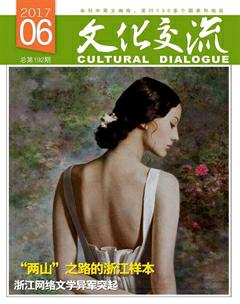东浦黄酒小镇:始于黄酒,忠于味蕾
朱申琪
绍兴老酒出东浦,东浦十里闻酒香。东浦镇位于绍兴市西郊,距离绍兴城区7公里,属于宁绍平原。
清代的绍兴东浦,油漆匠阿根师傅的母亲即将迎来八十大寿。往常村里人祝寿,会挑一坛上好的黄酒,并在装酒的陶坛外用红纸写上“寿”字以贺之,可阿根师傅觉得这陶坛既普通也不好看,于是突发奇想:能否在陶坛外用泥塑的形式,让陶坛与众不同一些?他日夜构思,反复试验,最终在储酒的陶坛上泥塑了一位老寿星形象,还在四周雕刻出百花装饰点缀,最后用自己的漆匠手艺,施之各种色彩,使原本平淡无奇的陶坛焕然一新。这不,阿根师傅的创意一经实现,立刻传遍了全东浦。日后,这种雕了花的酒坛就成为了绍兴酒包装的代表,梅兰竹菊、神话传说、山水风光、经典人物,无不成了雕花内容,而这原本的绍兴加饭酒,也多了一个雅称:花雕。这便是花雕酒的来历。
东浦自古就是“以楫为马、以舟代车、以桥为路”的水乡泽国,据不完全统计,境内仅各式各样的古桥就有216座,这些古桥的建造时间上自明清,下至民国,造型或拱梁结合,或拱涵配套,或长虹卧波,匠心别具,不一而足。在东浦古镇的老街上,有一座“酒木桥”(又称新桥),这座三孔石拱桥上雕刻有大楷楹联:“浦北中心为酒国;桥西出口是鹅池。”点出了东浦的特产是酒。
要说东浦的酒为何如此出名,“天下灵泉汇鉴湖,制成佳酿色香殊”可一语道破。正所谓水乃酒中血,东浦境内的鉴湖水,水质清冽,水色澄澈,且含有特殊的矿物质和微量元素,酿酒非他水可以代替。追溯起来,东浦的酿酒历史迄今已近2000年,宋代的东浦,已是绍兴酿酒业的中心。“莫道农家腊酒浑,丰年留客足鸡豚。”东浦人陆游当时在江南水乡小村做客,农家主人端出腊月里自酿的米酒招待,这酒的外表虽有些浑浊,但味道却有如名酒般醇美,美酒佐肴馔,诗人好不尽兴畅快。
四月微风和煦,漫步在东浦古镇的老街上,清人孙垓笔下的“村店村桥入画时……水气着意闻酒香”的意境悠然而起。老街上,街沿着河走,河连着石桥,人家濒河而居。在一处天井,主人正准备摆桌吃午饭。八仙桌上,一个大号的雪碧瓶里装满了乳清色的米酒。女主人旋开瓶盖,往一只白瓷兰花大碗中徐徐而倒,米酒的醇香立刻飘散开来。男主人端起大碗“喇”一口,配以一碟子爆炒螺蛳,忘情而陶醉,正是“笃螺蛳过酒,强盗来了勿肯走”。这乳清色的米酒是自家酿的老酒,属于淋饭酒,它在酿制过程中因只加酒药未入曲,并未着色,因此酒液之色宛如淘米后的水呈乳清色。这种米酒口感鲜爽,酒精度数也不高,很适宜大口饮用,尤其适合劳作之后感到体乏口干之人。也正因如此,这酒又极易叫人“上当”,因为它的后劲很大,入口味甜却容易喝醉。
石板路、小弄堂、马头墙、黑屋瓦,东浦老街上巷弄众多,游览时很容易绕迷糊。但走着、走着就会发现,老街上的每一条弄堂都是贯通的,不禁让人遐想,以前做酒的人家若正好开坛吊酒,这绵长的老酒醇香定能钻到隔壁巷子的最深处。
明清时期,东浦境内已有酒作坊400多家,其中一家叫“孝贞”的酒坊,得到过明武宗御笔题写的坊额和清乾隆皇帝御赐的金爵商标,其出品的竹叶青酒成为进京贡酒。清至民国,酒坊在扩大酿酒量的同时,更加注重黄酒质量的提高和品种的增加,除传统的元红、加饭、竹叶青等品种外,还增加了比较高档的香雪、善酿等。1912年,东浦乡云集酿坊的吴阿惠师傅用糯米饭、酒药和糟烧试酿了一缸绍兴酒,此酒酿造时不加麦曲,只用白色酒药,且酿酒时以陈年糟烧代替水,成为一种特殊的“双套酒”。因未加麦曲,该酒酒液淡黄清亮,其酒糟色如白雪,且糟烧味浓,酒香芬芳,因此取名为“香雪”。而善酿也是一种“双套酒”,因酿酒徒儿在做酒的兑水环节,错把元红酒当水加在酒缸里,可令人惊喜的是,这“错酿”的酒比原先的更为甘醇。1915年,东浦人周清将自己酿造的云集信记美酒,送到美国旧金山巴拿马太平洋万国博览会上,为绍兴酒捧得了第一枚国际金奖,从此云集之酿声名远播。
如今的东浦老街,正在进行古镇核心区的综合改造,临河的古镇建筑修缮,均遵循修旧如旧的宗旨。坐在廊檐下晒太阳的老奶奶直叹老街变化大,她会十分严肃地告诉你:现在,再也不能去河埠头洗衣服了,城管管得可严哩!令老人欣慰的是,老街的河水一天比一天清澈,她感觉自己就住在风景里。沿着古镇老街的青石板路走,便来到徐锡麟故居,辛亥革命先烈徐锡麟少年时期,曾在此读书、生活。现在,东浦镇上还保留着浙江省文物保护单位热诚学校。热诚学校创建于1904年,由徐锡麟和陈子英等人创办,名称取自徐锡麟所撰写的对联“有热心人可与共学;具诚意者得入斯堂”。
越王句践“箪醪劳师”,众将士迎流而饮,士卒感奋;王羲之兰亭修禊流觞曲水,以一觞一咏畅叙幽情;陆放翁一怀愁绪以酒浇愁,挂念着那红酥手与黄滕酒。一日千载。目前,特色小镇黄酒小镇正在按照“一镇两区”的联创模式建设,越城东浦片区依托丰富的古镇资源,重点发展黄酒文化产业;柯桥湖塘片区依托雄厚的产业基础,重点发展黄酒酿造产业。一座黄酒小镇展示馆,目前已在东浦片区的民俗文化街区内落成。在展示馆的酒香文化历史展区内,布展以东方人眼中的古镇和西方人镜头下的水乡为视角,展示了古镇的历史风貌和风土人情。
绍兴是一座底蕴深厚的历史文化名城,东浦黄酒小镇也在纵横联动绍兴相关的旅游景点。去过鲁迅故里和咸亨酒店,温上两碗酒,要一碟茴香豆,再到东浦古镇的老街走一走,这里有前店后坊式的观光型黄酒手工作坊,酿酒师傅驻守在店里,游客可以体验黄酒的制作过程和酒坛的浮雕刻画工艺,也可以品尝不同品种的黄酒,得到嗅觉、视觉、味觉的共同满足。在这些手工作坊里,除了传统的元红、加饭、善酿、香雪、竹叶青、花雕、甜酒酿之外,如今还有了黄酒棒冰、黄酒巧克力、黄酒奶茶等新成员加入黄酒大家庭。
东浦黄酒小镇核心区围绕黄酒主题,除了黄酒工艺和酒器展示,也在寻觅同黄酒最般配的业态和衍生品。目前,黄酒小镇已与绘璟轩顺风镖局、四娘臭豆腐、陈记扯白糖、李记酱货铺、嵊州醉小笼、越窑日铸茶、藕粉小铺、泰辰居茶楼、享绍阁等9家商户签订招商合同,2017年5月底,在核心区一期实现7家业态试营业。6月初,云集昌记酒坊和同泰當铺也将试营业。
美酒總是与美食相映成趣,在经典的绍兴菜中,有许多与酒有关的食物。绍兴莲花落《唐伯虎点秋香》中船老大出场时有段唱词:“……搬出下饭廿四样,鱼、虾、蟹、肉、酱,腊鸡腊鸭腊大肠,糟鸡糟鹅糟白鲞……”这里说到的糟鸡、糟鹅、糟白鲞要用到糟烧酒。糟烧,是以黄酒压榨后的糟粕为原料,经进一步发酵后蒸馏而成的。绍兴菜还有用大量黄酒入菜的醉系列:醉蟹、醉虾、醉麻蛤等。醉系列,就是先把食材醉倒,再让食客陶醉。
(本文照片由作者拍摄、提供)
Its All about Wine
The Wine-making Tradition of Dongpu Town
By Zhu Shenqi
Justifiably the crown jewel of rice wine artistry in China, Shaoxing wine is the product of a highly specialized technical process that has been perfected across several ancient Chinese dynasties. This time-tested wine-making craftsmanship not only plays a significant role in the culture of this world-renowned water town, but also makes cloning impossible.
Naturally endowed with fertile soil enriched by four distinctive seasons, Shaoxing has been born under a lucky star with regards to making wine: the Jianhu Lake area has long been a key player in the citys winemaking industry.
The wine-making history of Dongpu Town in Shaoxing dates back to 2,000 years ago. The town became Shaoxings wine-making leader in the Song Dynasty (960-1279). Legend has it that the Song poet Lu You (1125-1210), who was born in Dongpu, was a huge fan of Shaoxing wine throughout his life.
Seated in the western outskirts of Shaoxing City, the lovely town is also known for its large number of ancient bridges. The wine-making industry of Dongpu reached its heyday in the Ming (1368-1644) and Qing (1644-1911), when the town had more than 400 wineries. The ‘zhuyeqing wine crafted by a brewery called Xiaozhen was highly valued by Emperor Wuzong and Emperor Qianlong. The famous Shaoxing ‘ rice wine was invented by a wine-maker in the town in 1912. The making of Xiangxue features the use of wine sediment in the making process as a substitute for water. The result is remarkably strong taste and the exemplary snow-white color of the wine waste due to the absence of the wheat that turns the color of wine darker. The period also saw the birth of ‘Shanniang, the recipe of which using 1 to 3-year-old Yuanhong wine to replace water in the process of fermentation which brings about its unique penetrating fragrance and extra sweetness to the final product. In 1915, a man named Zhou Qing brought his wine to the Panama-Pacific Exposition held in San Francisco and came home with the first gold medal won by Shaoxing Wine at an international fair.
The citys vigorous urban reconstruction based on cultural conservation has effected great changes to the life of the townspeople. Water pollution is being wiped out, with the towns history and culture well-retained. Dongpu is the birth place of Xu Xilin (1873 – 7 July 1907), a Chinese revolutionary. Xu spent his childhood and adolescent years in the town. Xu set up a public school called Rechen in Shaoxing with Chen Ziying and several other like-minded friends in 1904. The school is now under provincial-level cultural protection.
For tourists who have visited such cultural hallmarks as the Former Residence of Lu Xun and Xianheng Restaurant in downtown Shaoxing, Dongpu Town offers a nice option for a relaxed ending of the cultural exploration of Chinas most famous water town. One can take a leisurely stroll and stop at one of the bustling little towns wine-making workshops to be soaked up in the intoxicating rice wine perfume and have a taste of the four core categories of Shaoxing wine: predominantly, , and and lots of fancy wine-flavored snacks such as rice wine chocolate, rice wine milk tea and wine ice-cream stick.
What wine lovers can see in the ‘Shaoxing Wine Town in Dongpu is a first-hand experience of the historical development of Shaoxings wine tradition. Here one can feast the eye on the magnificent wine-making crafts and a dazzling collection of drinking vessels and cultural products related to the citys wine tradition, and peruse an array of time-honored Shaoxing signature snack shops, teahouses and groceries. Nine shops in the towns core area are on trial operation and open to tourists.
Rice wine plays an essential role in the culinary glory and uniqueness of Shaoxing, serving as a magic flavoring agent and forever inspiring the citys literary and artistic minds. The Shaoxing-developed art of using wine in culinary innovations is second to none. A magnificent example of the culinary boldness of Shaoxing people is its ‘drunken innovations, represented by ‘, shrimps in wine which uses male shrimps from the Jianhu Lake only.

